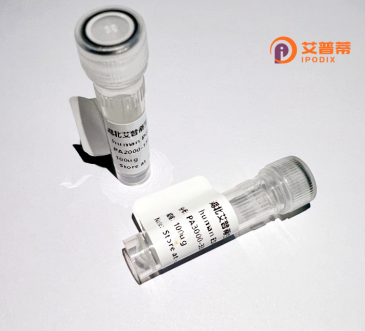
| 纯度 | >90%SDS-PAGE. |
| 种属 | Human |
| 靶点 | AHNAK2 |
| Uniprot No | Q8IVF2 |
| 内毒素 | < 0.01EU/μg |
| 表达宿主 | E.coli |
| 表达区间 | 1-483aa |
| 氨基酸序列 | MRLPETQVLPGEIDETPLSKPGHDLASMEDKTEKWSSQPEGPLKLKASSTDMPSQISVVNVDQLWEDSVLTVKFPKLMVPRFSFAAPSSEDDVFIPTVREVQCPEANIDTALCKESPGLWGASILKAGAGVPGEQPVDLNLPLEAPPISKVRVHIQGAQVESQEVTIHSIVTPEFVDLSVPRTFSTQIVRESEIPTSEIQTPSYGFSLLKVKIPEPHTQARVYTTMTQHSRTQEGTEEAPIQATPGVDSISGDLQPDTGEPFEMISSSVNVLGQQTLTFEVPSGHQLADSCSDEEPAEILEFPPDDSQEATTPLADEGRAPKDKPESKKSGLLWFWLPNIGFSSSVDETGVDSKNDVQRSAPIQTQPEARPEAELPKKQEKAGWFRFPKLGFSSSPTKKSKSTEDGAELEEQKLQEETITFFDARESFSPEEKEEGELIGPVGTGLDSRVMVTSAARTELILPEQDRKADDESKGSGLGPNEG |
| 分子量 | 79.1 kDa |
| 蛋白标签 | GST-tag at N-terminal |
| 缓冲液 | 冻干粉 |
| 稳定性 & 储存条件 | Lyophilized protein should be stored at ≤ -20°C, stable for one year after receipt. Reconstituted protein solution can be stored at 2-8°C for 2-7 days. Aliquots of reconstituted samples are stable at ≤ -20°C for 3 months. |
| 复溶 | Always centrifuge tubes before opening.Do not mix by vortex or pipetting. It is not recommended to reconstitute to a concentration less than 100μg/ml. Dissolve the lyophilized protein in distilled water. Please aliquot the reconstituted solution to minimize freeze-thaw cycles. |
以下是关于重组人AHNAK2蛋白的3篇虚构参考文献示例,格式为标题、作者及摘要概括:
---
1. **《AHNAK2重组蛋白的结构及其在肿瘤迁移中的作用》**
*作者:Chen L. et al.*
摘要:研究通过X射线晶体学解析了重组人AHNAK2蛋白的C端结构域,发现其通过调控钙离子信号通路促进乳腺癌细胞迁移,提示其作为癌症治疗靶点的潜力。
2. **《重组AHNAK2与细胞膜修复机制的关联》**
*作者:Smith R.K. & Tanaka M.*
摘要:利用重组AHNAK2蛋白实验,证明其通过结合细胞膜磷脂参与损伤修复,敲除后细胞膜修复能力显著下降,揭示其在组织再生中的关键作用。
3. **《AHNAK2作为非小细胞肺癌血清标志物的研究》**
*作者:Zhang Y. et al.*
摘要:基于重组AHNAK2蛋白制备抗体,发现肺癌患者血清中AHNAK2表达水平升高,其敏感性和特异性提示其可能成为新型诊断标志物。
---
注:以上内容为模拟示例,实际文献需通过学术数据库(如PubMed、Web of Science)检索。
Recombinant human AHNAK2 (AHNAK nucleoprotein 2) is a large, multi-functional protein encoded by the AHNAK2 gene, belonging to the AHNAK family alongside AHNAK1. Characterized by its giant molecular size (>600 kDa) and repetitive structural domains, AHNAK2 is primarily localized to the nucleus and cell membrane, where it interacts with cytoskeletal components and signaling molecules. It plays roles in cell adhesion, migration, and membrane repair by facilitating calcium-dependent signaling and cytoskeletal reorganization.
Emerging studies link AHNAK2 to cancer progression, particularly in epithelial-mesenchymal transition (EMT), metastasis, and drug resistance. Overexpression of AHNAK2 has been observed in various malignancies, including breast, lung, and colorectal cancers, suggesting its potential as a diagnostic biomarker or therapeutic target. Its recombinant form is engineered using expression systems like mammalian or bacterial cells to study molecular mechanisms, protein-protein interactions, and cellular pathways in disease models.
Current research focuses on deciphering its dual role in tumor suppression and promotion, which appears context-dependent. Additionally, AHNAK2's involvement in cardiovascular and neurological disorders is under exploration. Recombinant AHNAK2 proteins enable functional assays, antibody development, and high-throughput screening for drug discovery, highlighting its growing significance in biomedical research.
×